.
19.03.2014
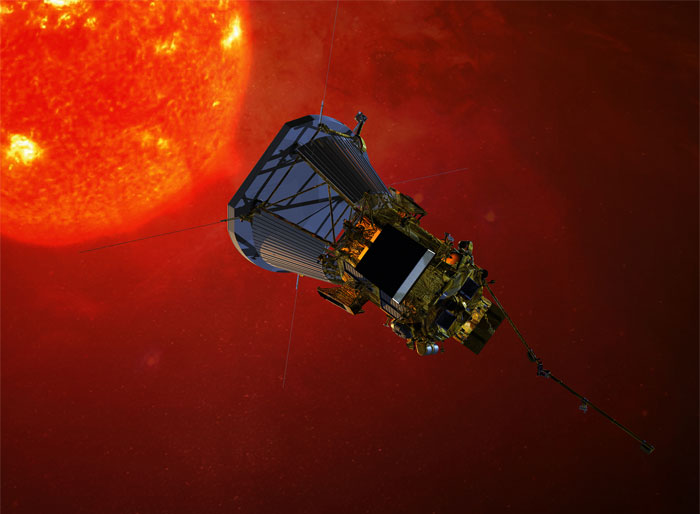
Artist’s impression of NASA’s Solar Probe Plus spacecraft on approach to the sun. Set to launch in 2018, Solar Probe Plus will orbit the sun 24 times, closing in with the help of seven Venus flybys. The spacecraft will carry 10 science instruments specifically designed to solve two key puzzles of solar physics: why the sun’s outer atmosphere is so much hotter than the sun’s visible surface, and what accelerates the solar wind that affects Earth and our solar system. The Johns Hopkins University Applied Physics Laboratory manages the Solar Probe Plus mission for NASA and leads the spacecraft fabrication, integration and testing effort.
Credit: NASA/Johns Hopkins University Applied Physics Laboratory
.
Solar Probe Plus Moves into Advanced Development
.
Solar Probe Plus — NASA’s ambitious mission to fly through and examine the sun’s atmosphere — has reached a key stage of development.
Solar Probe Plus will begin advanced design, development and testing — a step NASA designates as Phase C — following a successful design review in which an independent assessment board deemed that the mission team, led by the Johns Hopkins University Applied Physics Laboratory (APL) in Laurel, Md., was ready to move ahead with full-scale spacecraft fabrication, assembly, integration and testing.
.

Technicians at the Johns Hopkins University Applied Physics Laboratory in Laurel, Md., prepare an engineering model of the Solar Probe Plus Thermal Protection System, or TPS, for vibration tests in October 2013. The main feature of the TPS is an 8-foot-diameter, 4.5-inch-thick, carbon-carbon, carbon foam shield that will sit atop the Solar Probe Plus spacecraft body. The system will protect Solar Probe Plus from temperatures exceeding 2,500 degrees Fahrenheit and impacts from hypervelocity dust particles as it flies through the sun’s outer atmosphere. The vibration tests simulate the shaking the spacecraft will undergo during launch; Solar Probe Plus is scheduled to launch in 2018.
Credit: Johns Hopkins University Applied Physics Laboratory
.
“Solar Probe Plus will fly closer to the sun than any spacecraft before it — almost 10 times closer to the sun than the planet Mercury — and this presents unprecedented technical challenges,” says Andrew Driesman, Solar Probe Plus project manager at APL. “Whether it was devising ways for a spacecraft to survive so close to the sun, or to collect data in such an extreme environment, the concept of an operational solar probe had challenged engineers and scientists for decades, and now we’re another step closer to making it happen.”
Set to launch in 2018, Solar Probe Plus will orbit the sun 24 times, closing in with the help of seven Venus flybys. At its closest passes the probe will speed 118 miles per second through the sun’s outer atmosphere, or corona, coming about 3.8 million miles (about 6.2 million kilometers) from the surface to explore a region — and face hazards — no other spacecraft has encountered. Solar Probe Plus will carry 10 science instruments specifically designed to help solve two key puzzles of solar physics: why the sun’s outer atmosphere is so much hotter than the sun’s visible surface, and what accelerates the solar wind that affects Earth and our solar system.
“The answers to these questions can be obtained only through in-situ measurements of the solar wind down in the corona,” says APL’s Nicky Fox, Solar Probe Plus project scientist. “Solar Probe Plus gets close enough to provide the missing links, with the right complement of instruments to make the measurements. For the first time, we will be able to go up and touch our star.”
APL, which manages the mission and leads the spacecraft fabrication and integration effort, has made significant progress on several enabling technologies, such as the carbon-carbon composite heat shield that will protect Solar Probe Plus from temperatures exceeding 2,500 degrees Fahrenheit and impacts from hypervelocity dust particles. Engineers have also built and tested a liquid-cooling system to keep the spacecraft’s solar arrays at safe operating temperature throughout the voyage, and spacecraft parts are undergoing high-velocity dust tests that simulate flights through swarms of high-energy particles near the sun.
“Solar Probe Plus is a pathfinder for voyages to other stars and will explore one of the last unexplored regions of the solar system, the solar corona, where space weather is born,” says Lika Guhathakurta, Solar Probe Plus program scientist at NASA Headquarters in Washington.
The Solar Probe Plus team includes engineers, scientists, technicians and other experts from government, academia and industry. The mission is part of NASA’s Living With a Star program, designed to learn more about the sun and its effects on planetary systems and human activities. NASA’s Goddard Space Flight Center in Greenbelt, Md., manages the program for the Science Mission Directorate at NASA Headquarters.
.
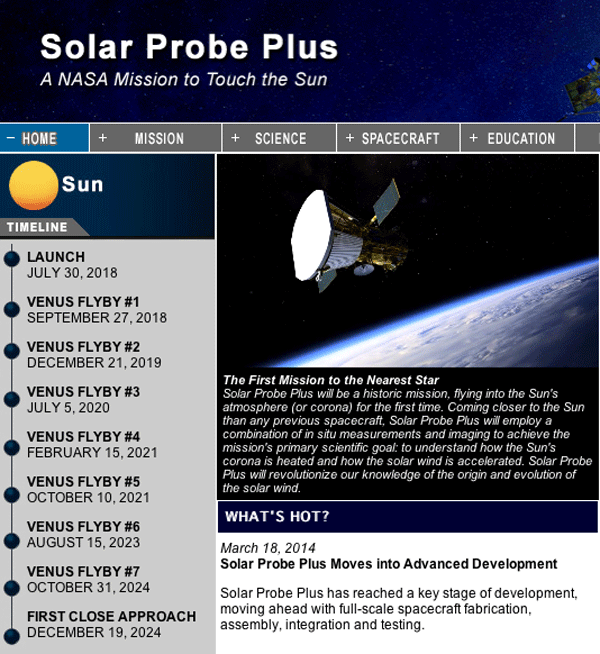
.
Quelle: The Johns Hopkins University Applied Physics Laboratory LLC.
-
Update: 9.04.2015
.
NASA Gives Green Light for Johns Hopkins APL to Begin Building Solar Probe Plus Spacecraft
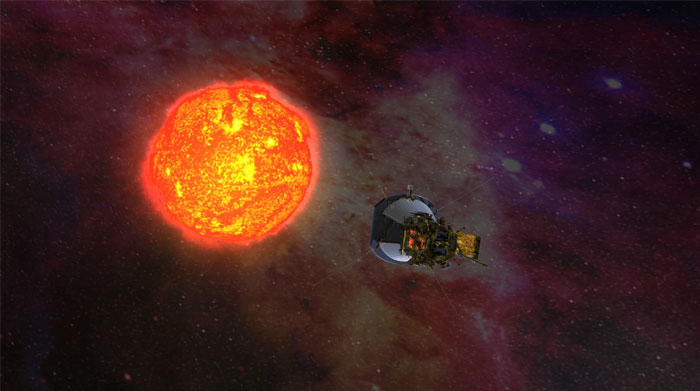
Artist rendering of Solar Probe Plus, solar panels folded into the shadows of its protective shield, as it gathers data on its approach to the sun.
-
NASA’s Solar Probe Plus mission — which will fly closer to the sun than any spacecraft has before — reached a major milestone last month when it successfully completed its Critical Design Review, or CDR.
An independent NASA review board met at the Johns Hopkins University Applied Physics Laboratory, or APL, in Laurel, Maryland, March 16-20, 2015, to review all aspects of the mission plan. APL has designed and will build and operate the spacecraft for NASA. The CDR certifies that the Solar Probe Plus mission design is at an advanced stage and that fabrication, assembly, integration and testing of the many elements of the mission may proceed.
Solar Probe Plus is scheduled to launch aboard a United Launch Alliance Delta 4-Heavy rocket with an upper stage from Cape Canaveral Air Force Station, Florida. The launch window opens for 20 days starting on July 31, 2018. Over 24 orbits, the mission will use seven flybys of Venus to reduce its distance from the sun. The closest three will be just 3.8 million miles from the surface of the star.
Scientists have long wanted to send a probe through the sun’s outer atmosphere, or corona, to better understand the solar wind and the material it carries into our solar system. The primary science goals for the Solar Probe Plus mission are to trace the flow of energy and understand the heating of the solar corona and to explore the physical mechanisms that accelerate the solar wind and energetic particles.
To meet those objectives, Solar Probe Plus will carry four instrument suites into the corona and study the solar wind and energetic particles as they blast off the surface of the star. These instruments will study magnetic fields, plasma, and energetic particles, and will image the solar wind. The instruments are: the Fields Experiment from the University of California Space Sciences Laboratory, Berkeley, California; the Integrated Science Investigation of the Sun from the Southwest Research Institute, San Antonio; the Solar Wind Electrons Alphas and Protons Investigation from the Smithsonian Astrophysical Observatory, Cambridge, Massachusetts; and the Wide Field Imager for Solar Probe Plus from the Naval Research Laboratory, Washington, D.C.
The spacecraft and instruments will be protected from the sun’s heat by a 4.5-inch-thick carbon-composite shield. During the closest passes around the sun, temperatures outside the spacecraft will reach nearly 2,500 degrees Fahrenheit.
Solar Probe Plus is part of NASA’s Living With a Star Program to explore aspects of the connected sun–Earth system that directly affect life and society. LWS is managed by NASA's Goddard Space Flight Center in Greenbelt, Maryland, for NASA’s Science Mission Directorate in Washington.
Quelle: NASA
-
Update: 19.07.2016
.
Solar Probe Plus Mission Moves Closer to 'Touching the Sun' in 2024
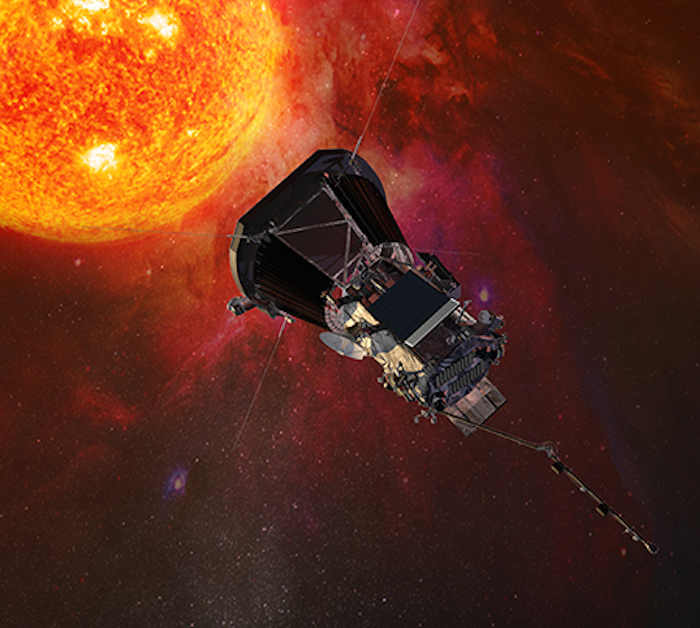
Artist’s conception of the Solar Probe Plus spacecraft near the Sun. Image Credit: NASA/JHUAPL
-
The Solar System is a busy place, with spacecraft currently visiting most of the planets as well as some dwarf planets and comets. Akatsuki is at Venus, several rovers and orbiters are at Mars, the Juno spacecraft just reached Jupiter, Cassini is still orbiting Saturn, Dawn is still at Ceres, and Rosetta continues to study the comet 67P. Mercury, Uranus, Neptune, and Pluto have all been visited by previous missions as well. But there is one other place in the Solar System which will also be explored more closely in the near future: the Sun.
The Sun may seem like an unlikely place to want to send a probe since you can only get so close before being fried to dust. NASA wants to do just that, however, with a new mission called Solar Probe Plus. The mission, which will be the first to “touch” the Sun’s outer atmosphere, is now on track for a planned launch in the summer of 2018, with a first close approach in 2024.
The mission has just passed a critical development milestone, with a successful NASA management review on July 7. It is now moving into the system assembly, integration, test, and launch stage, known as Phase D, which continues until launch.
“Reaching this stage means a lot to the team and our stakeholders,” said Andy Driesman, Solar Probe Plus project manager at the Johns Hopkins Applied Physics Laboratory (JHUAPL), which manages the mission for NASA and is building the spacecraft. “It shows we’ve designed a spacecraft, instruments and a mission that can address the engineering challenges associated with the harsh solar environment, and send back the data that scientists have sought for decades. It’s humbling to see designs and ideas start to become a spacecraft.”
.
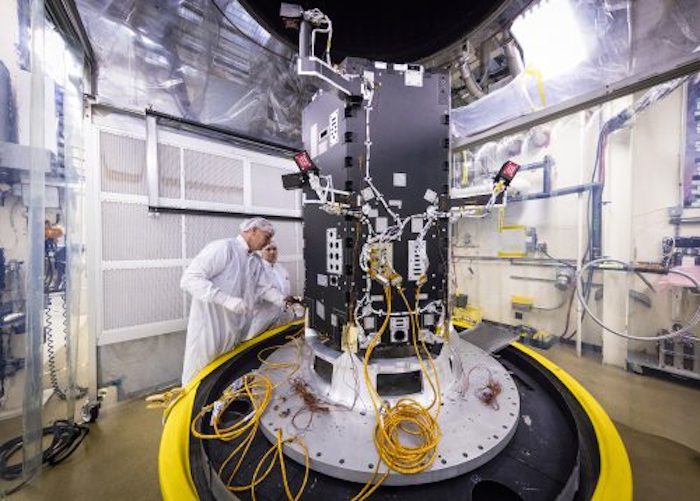
The Solar Probe Plus under construction at the Johns Hopkins University Applied Physics Laboratory in Laurel, Md. Photo Credit: NASA/JHUAPL
.
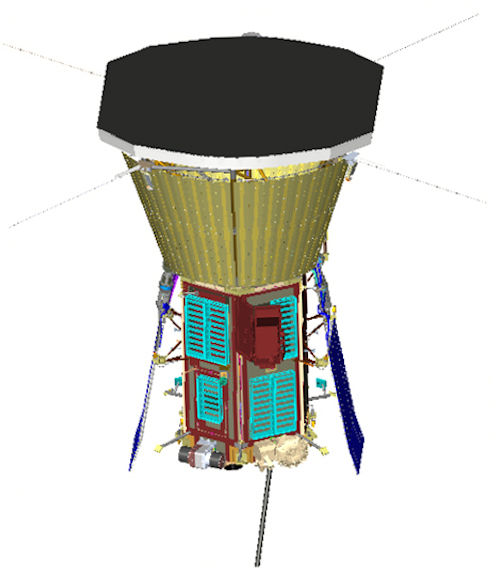
Illustration of the Solar Probe Plus spacecraft. Image Credit: JHUAPL
-
The spacecraft itself will be about 8 feet (2.4 meters) in diameter and weigh 1,350 pounds (612 kilograms).
SPP won’t get too close, but it will pass several times through the Sun’s outer atmosphere, the corona, during a period of 24 orbits, to collect data. With each pass, it will move a bit closer to the Sun. At its closest, during three orbits, it will pass within 3.9 million miles (6.3 million kilometers) of the Sun’s surface, which is about seven times closer than any previous spacecraft has been, including ones at Mercury. The solar energy at that distance will be immense, about 500 times more than spacecraft tend to have to deal with at Earth’s distance from the Sun. Mercury, by comparison, is 35.98 million miles (57.9 million kilometers) from the Sun. A 4.5-inch (11.4-centimeter) thick carbon-composite shield will protect the probe’s instruments from temperatures reaching nearly 2,500 degrees Fahrenheit (1,371 degrees Celsius). The previous record holder was the Helios 2 spacecraft, which passed about 27 million miles (44 million kilometers) from the Sun in April 1976.
The main objectives of the mission include obtaining new data on solar activity to help to better forecast space-weather events like solar flares which can directly impact Earth and orbiting satellites, trace the flow of energy from the Sun, better understand how the Sun’s outer atmosphere is heated, and explore the physical mechanisms which accelerate the solar wind. The solar wind is the continuous stream of charged and energetic particles flowing out from the Sun, which can affect spacecraft.
Four different instrument suites on SPP will study the Sun’s magnetic fields, plasma, energetic particles, and solar wind. Five different science investigations include:
Solar Wind Electrons Alphas and Protons Investigation, which will specifically count the most abundant particles in the solar wind—electrons, protons, and helium ions—and measure their properties. The investigation also is designed to catch some of the particles in a special cup (known as a Faraday cup) for direct analysis. Principal Investigator: Justin C. Kasper, Smithsonian Astrophysical Observatory, Cambridge, Mass.
The Wide-field Imager, a telescope that will make 3-D images of the Sun’s corona, or atmosphere. The experiment actually will see the solar wind and provide 3-D images of clouds and shocks as they approach and pass the spacecraft. This investigation complements instruments on the spacecraft providing direct measurements by imaging the plasma the other instruments sample. Principal Investigator: Russell Howard, Naval Research Laboratory, Wash.
The Fields Experiment, which will make direct measurements of electric and magnetic fields, radio emissions, and shock waves that course through the Sun’s atmospheric plasma. The experiment also serves as a giant dust detector, registering voltage signatures when specks of space dust hit the spacecraft’s antenna. Principal Investigator: Stuart Bale, University of California Space Sciences Laboratory, Berkeley, Calif.
The Integrated Science Investigation of the Sun, which consists of two instruments that will take an inventory of elements in the Sun’s atmosphere using a mass spectrometer to weigh and sort ions in the vicinity of the spacecraft. Principal Investigator: David McComas, Southwest Research Institute, San Antonio.
Heliospheric Origins with Solar Probe Plus Principal Investigator Marco Velli, of NASA’s Jet Propulsion Laboratory, Pasadena, Calif., is the mission’s observatory scientist, responsible for serving as a senior scientist on the science working group. He will provide an independent assessment of scientific performance and act as a community advocate for the mission.
A few “fun facts” about the mission include:
Solar Probe Plus will orbit the Sun 24 times, gradually “walking in” toward the Sun with each pass. The closest points of each orbit come well within orbit of Mercury, the closest planet to the Sun.
On the final three orbits, Solar Probe Plus will fly to within 8.5 solar radii of the Sun’s “surface” 8.5 solar radii is 8.5 times the radius of the Sun, or about 3.7 million miles. That is about seven times closer than the current record-holder for a close solar pass, the Helios spacecraft.
At closest approach, Solar Probe Plus will be hurtling around the Sun at approximately 450,000 miles (739,000 kilometers) per hour! That’s fast enough to get from Philadelphia to Washington, D.C., in one second.
Solar Probe Plus will pass Venus less than two months after launch and will be collecting science data at its first solar pass just one month later.
At closest approach to the Sun, while the front of Solar Probe Plus’ solar shield faces temperatures approaching 2,500 degrees Fahrenheit (or about 1,400 degrees Celsius), the spacecraft’s payload will be near room temperature.
The mission was first approved back in April 2015, after completing a Critical Design Review (CDR).
“The completion of CDR is a testament to the focused, diligent work of APL, NASA, the instrument teams and our industry partners,” said Driesman. “We’re excited to continue working on a difficult mission that’s been more than 50 years in the making, one that is now achievable thanks to advances in technology, materials and design.”
.
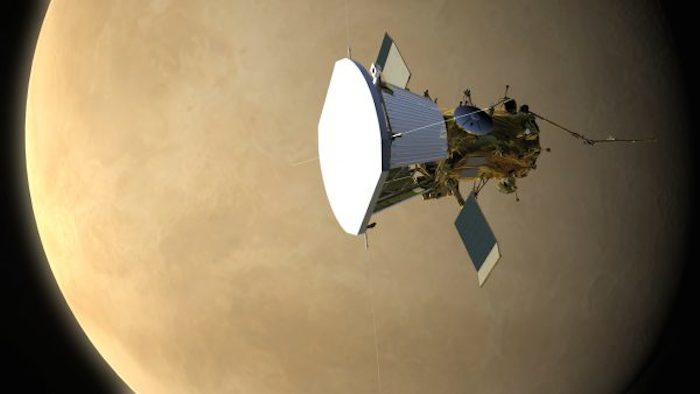
Solar Probe Plus will make several close flybys of Venus during its mission. Image Credit: JHU/APL
-
Solar Probe Plus is scheduled to launch aboard a United Launch Alliance Delta 4-Heavy rocket with an upper stage from Cape Canaveral Air Force Station in Florida, with a launch window opening for 20 days starting on July 31, 2018. The mission timeline, in brief:
Launch – July 31, 2018
Venus flyby #1 – Sept. 27, 2018
Venus flyby #2 – Dec. 21, 2019
Venus flyby #3 – July 5, 2020
Venus flyby #4 – Feb. 15, 2021
Venus flyby #5 – Oct. 10, 2021
Venus flyby #6 – Aug. 15, 2023
Venus flyby #7 – Oct. 31, 2024
First close approach – Dec. 19, 2024
Solar Probe Plus has actually been in a concept stage for the past 50 years, with various previous designs; the current design is based on a proposal from 2005, in a study performed at the Johns Hopkins University Applied Physics Laboratory (JHUAPL). The original design would have used nuclear power (an RTG engine), but that was replaced with the newer design, without the RTG and for less cost. The new design is actually capable of providing more science than before as well. Solar Probe Plus is the keystone of the Living With a Star (LWS) program.
Understanding how the Sun behaves is of course important since it can directly affect life on Earth. Our Sun is a relatively stable star, but changes in solar energy output, such as during massive solar flares, can still have an impact. The data gathered should also help scientists better understand other stars as well, especially ones which are similar to our Sun, and how this may affect the potential habitability of some exoplanets.
Quelle: AS
7978 Views
